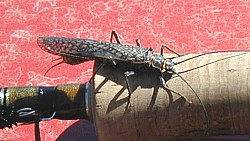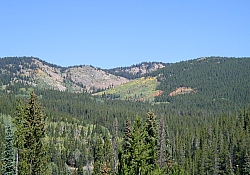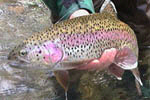|
While traipsing up and down the
spine of the northern Rocky Mountains in search of cutthroat trout,
Iíve come to rely on the Stimulator in all its variations of size
and color. From a size 18 in brown for early winter stones to
a size 4 in black and orange for the giant salmonflies of the
Rockies, this pattern has been a go-to fly for all types of water
and all seasons.

Photo courtesy of Gene Hall
The quest can start in February,
when a size 18 in black on a Mustad #94840 imitates snowflies on the
Kootenai River. In March, for early winter stones on the North
Platte I've used a size 16 in brown. And, in April on the
Clarks Fork and the Bitterroot, a size 12 or 14 tied in olive
imitates the Skawlas.
Early summer, right behind the
runoff, brings out the salmonflies and, if you can catch up with
them, some very large trout looking for a big easy meal. A
large black and orange or Royal Stimulator will catch fish slashing
at the large salmonflies.
A favorite trick of mine is to
fish a large Stimulator like a steelhead fly right down a current
seam, just under the surface. Iíve been rewarded with some very nice
fish using this method. On the tails of the salmonfly hatch,
the Golden Stones begin to fly. When this happens, a yellow
Stimulator or my variation, the Ice Golden Stone, gets the call.
Along with the Golden Stones,
willow flies and small chartreuse stones become available. Seldom
noticed by fishermen, but a favorite of trout, these small bright
green and yellow stoneflies are available to the fish throughout the
summer. A small yellow, olive, or bright green Stimulator can be
just the ticket.
High summer means ďHopper
TimeĒ. A large yellow Stimulator with the float, drown, and
swing tactic has been a constant producer on north Idahoís Kelly
River.

"Cutthroat Country", courtesy of Gene
Hall
With late summer the backcountry
streams from the South Fork of the Flathead, down through Idaho,
Montana, Wyoming, and Colorado come into shape. Now the size and
color is secondary to just plain having a couple of pockets full of
high floating, durable flies. Most of these streams fish well until
itís no longer possible to access them.
When the snow starts to fly and
pile up, itís time to start tying. After all, you only have a few
months to get all the sizes and colors youíll need for next season
finished.
--Gene Hall |



